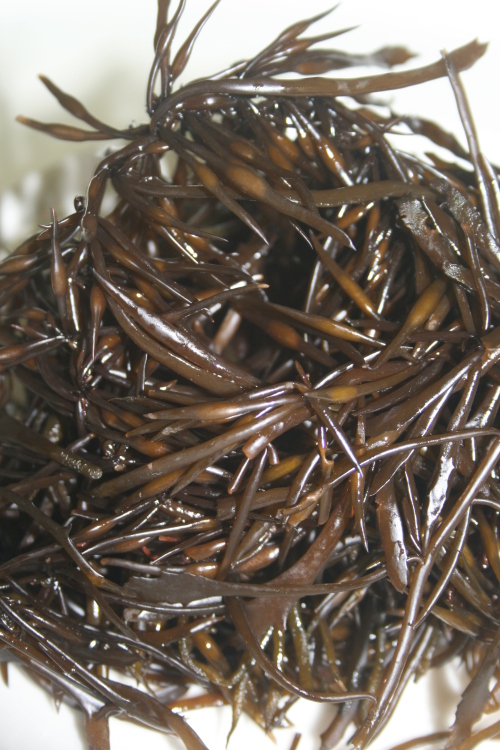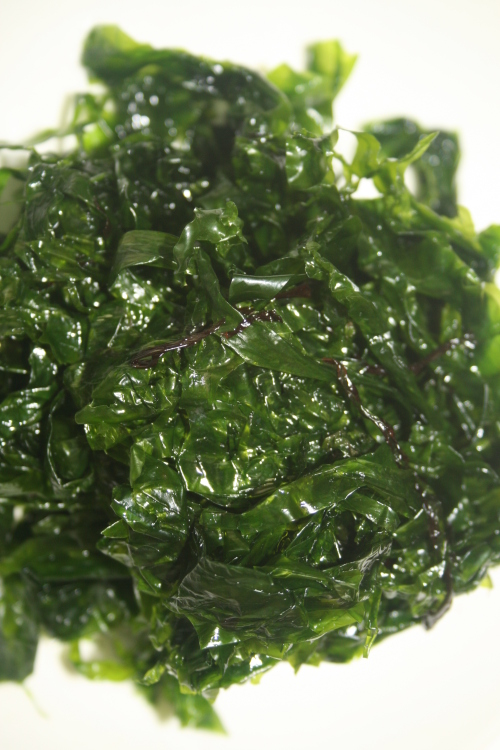For years now, seaweed has been touted by many for its various health and beauty benefits.
The sea plant has been featured as a key ingredient in prominent cosmetic and spa brands, and many will recognize it as the dark, glossy wrapper used to make the popular California sushi roll.
Despite all this, algae still remains something of a global novelty, especially when presented in forms drastically different from the laver that most are familiar with.
In Korea, however, seaweed is a staple of the daily diet.
The sea plant has been featured as a key ingredient in prominent cosmetic and spa brands, and many will recognize it as the dark, glossy wrapper used to make the popular California sushi roll.
Despite all this, algae still remains something of a global novelty, especially when presented in forms drastically different from the laver that most are familiar with.
In Korea, however, seaweed is a staple of the daily diet.

Here, miyeokguk (seaweed soup) is customarily eaten on birthdays, while squares of gim (laver) often adorn the dinner table.
Local supermarkets and marts sell a diverse array of healthy sea plants, including the winter delicacy, maesaengi (seaweed fulvescens), and other algae like tot (seaweed fusiforme) and parae (sea lettuce).

For those uninitiated to the world of edible sea greens, the wide range of seaweed on display may be intensely mind-boggling, with maesaengi, in particular, drawing notice for its slimy, blob-like appearance.
But don’t underestimate the gooey plant.
Rich in minerals, maesaengi is lauded for being nutritious and is considered to help rid the body of toxins and “purify” one’s blood.
The superfine, silken algae only grow in unpolluted areas off the southern coast like Jangheung-gun and Wando-gun in the South Jeolla Province from November or December to February, making it a delicacy indeed.
For those who want to try maesaengi, now is the perfect time.
Not only is it in season ― but, according to Samho Zzangdoongi owner Kim Myoung-hoon, whose restaurant specializes in the prized seaweed ― this winter’s maesaengi is very good.
“Because it snowed so much in the southern regions of Korea, the quality of this year’s maesaengi is excellent,” said Kim.
“Snow prevents the seaweed from oxidizing,” he explained.
The Jeolla Province native delved into the history of the fine-haired algae, elaborating on how maesaengi was originally considered a pesky weed by gim farmers in areas like Wando-gun.
“The maesaengi would get tangled in with the gim, and when they both dried together, the gim would just crumble and fall apart,” he said. “So gim farmers would end up ruining their hands during the winter while picking maesaengi off the gim.”
Instead of discarding the annoying algae, they tried boiling it and discovered that it was delicious. Oysters were added to perfect the classic soup dish.
“Only 10 years have passed since maesaengi started to get noticed,” he continued. “What used to be a traditional South Jeolla Province dish is now considered a health food staple in Gangnam.”
When trying maesaengi soup, diners should slurp it gently because, according to Kim, hot maesaengi does not give off any steam, so it looks like it has cooled down, when, in fact, one brash spoonful might leave one nursing a scalded tongue.

“Maesaengi is the thinnest algae,” said Kim, who brought out other seaweed banchan served at his restaurant, like the prickly-looking tot and the near-thread-like gamtae (ecklonia cava), to illustrate his point.
Tot, in fact, along with parae, which is slightly thicker than maesaengi, can also be found in marts.
Parae is also loaded with minerals and is often enjoyed in the form of savory pancakes or as a type of gim or muchim (vegetable dish seasoned with vinegar).
Tot is also packed full of minerals and is rich in fiber. The spindly, tree-like seaweed has been dubbed an “elixir of the sea” because it is seen as very healthy. Koreans often prepare it as a muchim.
Where to eat
■ Samho Zzangdoongi
Located in Nonhyeon-dong, Seoul, this restaurant has specialized in traditional South Jeolla Province dishes like maesaengi soup and fermented skate for over a decade.
Maesaengi soup costs 10,000 won, is served up hot and fresh, filled with plump and sweet oysters, and comes with a diverse array of equally delicious banchan.
Owner Kim says they take a no-frills approach to their version of the traditional dish, primarily relying on the quality of the maesaengi and oysters to impart this smooth, nutty stew-like soup with its rich flavors and soft, smooth textures.
Until February, fresh maesaengi primarily from Jangheung-gun, with some from Wando-gun, will be used to make the establishment’s soup.
Opening hours are from 10 a.m. to 10 p.m. with a break between 3 p.m. to 5 p.m.
To get there go to Hakdong Subway Station Line 7, Exit 8 and walk straight for approximately six minutes. Turn right at Kookmin Bank and walk straight for 150 meters.
For more information call (02) 547-1416 or visit www.samzzang.co.kr.
■ The Shilla Jeju
Maesaengi and oyster hangover soup will be sold at the Jeju Island hotel’s Korean restaurant Cheonjee for breakfast for 24,000 won until the end of February. For more information, visit www.shilla.net or call (064) 735-5342.
How to make
The Shilla Jeju hotel head chef Lee Chang-youel shares recipes for maesaengi hangover soup and seasoned tot.
■ Maesaengi and Oyster Hangover Soup Recipe
Serves 2
Main ingredients
-200 g maesaengi
-200 g raw oysters
-1/4 block of tofu
-100 g bean sprouts
-1 green chili pepper
Ingredients for broth
-1.2 l water
-200 g littleneck clams
-1/2 green onion
-2 cloves garlic
-50 g of daikon radish
Seasoning
-2 tbsp soup soy sauce
-A pinch of salt
-1 tsp minced garlic
-1 tsp chopped green onion
Directions
1) Remove sediment from clams and boil in water for about five minutes. Remove clams and add 1/2 green onion, two cloves garlic and 50 g of daikon radish. Simmer for five more minutes and take out onion, garlic and radish. The broth is ready.
2) Soak maesaengi in just enough water to cover the maesaengi, and get rid of any sediment. Rinse it two to three times and then drain out water.
3) Clean oysters in salt water and then quickly rinse again in regular water. Drain out water.
4) Add 2 tbsp of soup soy sauce, a pinch of salt, 1 tsp of minced garlic, 1 tsp of sliced green onions to broth. Start to boil broth. Once the broth starts boiling add the following ingredients in the following order ― oysters, maesaengi, tofu, green onion and bean sprouts. Continue to boil a little bit more, then turn off the burner.
■ Tot Muchim Recipe
Ingredients
-200 g tot
-2 tbsp gochujang (red pepper paste)
-2 tsp doenjang (soybean paste)
-2 tbsp vinegar
-1 tbsp sugar
-1 tbsp red pepper powder
-1 tsp finely ground ginger
-2 tsp finely minced garlic
-1 tsp chopped Chungyang red pepper
-Small amount of chopped onion
-1 tsp chopped green onion
-2 tsp sesame seed oil
Directions
1) Blanch tot in boiling water then rinse in cold water and chop.
2) Combine gochujang, doenjang, vinegar, sugar, red pepper powder, grated ginger, finely chopped garlic, chopped Chungyang red pepper, chopped green onion, a little chopped onion and mix with tot. Add two tsp of sesame seed oil and mix.
By Jean Oh (oh_jean@heraldcorp.com)












![[Today’s K-pop] BTS pop-up event to come to Seoul](http://res.heraldm.com/phpwas/restmb_idxmake.php?idx=644&simg=/content/image/2024/04/17/20240417050734_0.jpg&u=)




![[KH Explains] Hyundai's full hybrid edge to pay off amid slow transition to pure EVs](http://res.heraldm.com/phpwas/restmb_idxmake.php?idx=652&simg=/content/image/2024/04/18/20240418050645_0.jpg&u=20240418181020)

![[Today’s K-pop] Zico drops snippet of collaboration with Jennie](http://res.heraldm.com/phpwas/restmb_idxmake.php?idx=642&simg=/content/image/2024/04/18/20240418050702_0.jpg&u=)